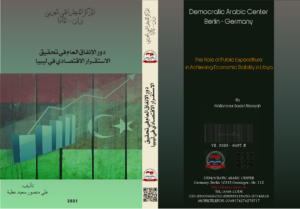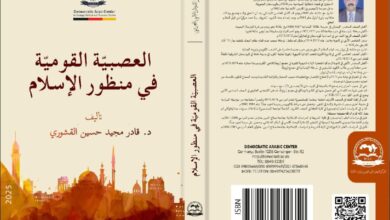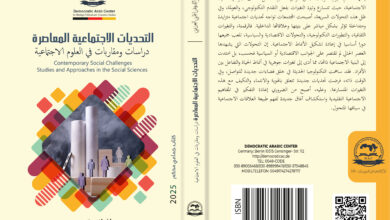دور الانفاق العام في تحقيق الاستقرار الاقتصادي في ليبيا
The Role of Public Expenditure in Achieving Economic Stability in Libya

تأليف : د. على منصور عطية
نسخة “pdf”-
دور الانفاق العام في تحقيق الاستقرار الاقتصادي في ليبيا
الطبعة الأولى “2021″ –من كتاب: – دور الانفاق العام في تحقيق الاستقرار الاقتصادي في ليبيا
جميع حقوق الطبع محفوظة #المركز_الديمقراطي_العربي ولا يسمح بإعادة إصدار هذا الكتاب أو اي جزء منه أو تخزينه في نطاق إستعادة المعلومات أو نقله بأي شكل من الأشكال، دون إذن مسبق خطي من الناشر .
تقديم:
تستهدف الدراسة التعرف على دور الإنفاق العام في تحقيق الاستقرار الاقتصادي في ليبيا خلال الفترة 1986م -2017م وذلك من خلال دراسة تطور الإنفاق العام وواقع الاستقرار الاقتصادي في ليبيا خلال فترة الدراسة، وكذلك تحليل العلاقة بين الإنفاق العام وأبعاد الاستقرار الاقتصادي في ليبيا، بالإضافة إلى قياس العلاقة بين الإنفاق العام والاستقرار الاقتصادي خلال فترة الدراسة. وقد اعتمدت الدراسة في منهجية البحث على البيانات الثانوية المنشورة من خلال مصرف ليبيا المركزي، ووزارة التخطيط في دولة ليبيا، وبيانات الأمم المتحدة المتاحة على شبكة المعلومات الدولية ، بالإضافة إلى بيانات البنك الدولي.
وقد تضمنت الدراسة ستة فصول تناول الفصل التمهيدي (الإطار العام للدراسة) في المبحث الأول منه مقدمة الدراسة ومشكلة وأهمية الدراسة وأهداف ومنهجية الدراسة. كما تناول المبحث الثاني للفصل الدراسات السابقة المتعلقة بالإنفاق العام وعلاقتهُ بأبعاد الاستقرار الاقتصادي، حيث تناول عرض لأهم نتائج الدراسات والأبحاث والرسائل العلمية ذات الصلة بموضوع الدراسة، وقد أسفرت نتائج الدراسة عن وجود اختلافات حول تناول موضوع الدراسة دور الإنفاق العام في تحقيق الاستقرار الاقتصادي حيث تختلف الدراسة عن الدراسات السابقة في الأوجه التالية:
- التمييز بين دور الإنفاق العام في تحقيق الاستقرار الاقتصادي بأبعاده المختلفة في الدول المتقدمة والدول النامية، مسترشدة بالتجربة النرويجية والتجربة الماليزية.
- ركزت الدراسة علي بحث العلاقة بين الإنفاق العام وأبعاد الاستقرار الاقتصادي المختلفة في الاقتصاد الليبي.
- قامت الدراسة ببناء مؤشر(دليل) لكي يُعبر عن الاستقرار الاقتصادي في الدول النامية وفقاً لمربع ” كالدور” السحري.
في حين خُصص الفصل الأول لدراسة الإطار النظري للإنفاق العام والاستقرار الاقتصادي حيث تناول المبحث الأول منه الدور الاقتصادي للإنفاق العام في النظرية الاقتصادية بدأ أولها باستعراض مفهوم الإنفاق العام في النظرية الاقتصادية وتفسير دور الإنفاق العام الاقتصادي من خلال عرض أهم المفكرين الذين اهتموا بهذا الجانب.
كما عرض المبحث أهم الأسباب الظاهرية والحقيقية وراء ازدياد الإنفاق العام، وقد تعرض المبحث الثاني من الفصل الأول لتناول الإطار النظري للاستقرار الاقتصادي وقد انتهت الدراسة في هذا المبحث إلى مايلي:
يختلف مفهوم الاستقرار الاقتصادي عند أبرز المدارس الاقتصادية المعاصرة وذلك بسبب اختلاف الظروف الاقتصادية والاجتماعية والسياسية بين الدول المتقدمة والدول النامية.
وقد انتهت نتائج هذا المبحث إلى أن الاستقرار الاقتصادي في الدول المتقدمة يهدف إلى المحافظة على مستوى التشغيل الكامل للموارد الاقتصادية المتاحة، وتحقيق درجة مناسبة من الاستقرار العام في الأسعار، بينما يهدف الاستقرار الاقتصادي في الدول النامية إلى تحقيق نمو مستقر، ومحاربة البطالة وتوفير العمل، وتحقيق التوازن الخارجي، ومحاربة التضخم، وأختص المبحث الثالث بالعلاقة بين الإنفاق العام وأبعاد الاستقرار الاقتصادي.
وأهتم الفصل الثاني بعرض تجربتا النرويج وماليزيا في دور الإنفاق العام في تحقيق الاستقرار الاقتصادي لكل من الدول المتقدمة والنامية حيث تناول المبحث الأول تجربة النرويج في مجال تحقيق الاستقرار الاقتصادي من خلال صندوق الثروة السيادي بينما تناول المبحث الثاني التجربة الماليزية في تحقيق الاستقرار الاقتصادي، بالرغم من أن ليبيا تمتلك صندوق سيادي (صندوق الاستثمار)، إلا أنه يعاني العديد من النقائص سواء من خلال اعتماده على مداخيل صادرات الطاقة، أو من خلال إدارته التي تعتبره مجرد حساب من حسابات الخزينة ولا يتبع أي معيار من معايير الحوكمة، مما لا يسمح بالاستغلال الأمثل لموارده بطريقة تسمح بمضاعفتها وهو ما جعلنا نعرض التجربة النرويجية في هذا الصدد، ولعل التجربة الماليزية التى اهتمت بالإنفاق في مجال الطاقة البشرية وبأسلوب التخطيط الذي يختلف تماماً عن النموذج السابق الذي تتوافر فيه الموارد المالية فمن الضروري أن يكمل كل منهما الآخر وهذا محور اهتمام الدروس المستفادة من التجربة الماليزية.
تضمن الفصل الثالث اتجاهات تطور الإنفاق العام وواقع الاستقرار الاقتصادي في ليبيا خلال الفترة 1986م -2017م، وقد تم تقسيم هذا الفصل إلى مبحثين حيث اهتم المبحث الأول باتجاهات تطور الإنفاق العام بالإضافة إلى تحليل تطور الإنفاق العام وتقدير معدلات الاتجاه الزمني العام خلال فترة الدراسة، بالإضافة إلى دراسة تطور الإنفاق الاستهلاكي بشقية(العائلي والحكومي) والإنفاق الاستثماري، حيث أسفرت النتائج أن الإنفاق الاستهلاكي الجاري مهيمناً على معظم سنوات الدراسة حيث بلغت نسبة مساهمة الإنفاق الاستهلاكي الجاري حوالي 61.90% في المتوسط في الفترة (1986-2017) مقارنة بالإنفاق الاستثماري الذي يساهم بحوالي 38.09% خلال فترة الدراسة.
وقد أهتم الفصل الرابع بتحليل العلاقة بين الإنفاق العام وأبعاد الاستقرار الاقتصادي في ليبيا خلال فترة الدراسة 1986م -2017م، وقد اعتمدت الدراسة – وذلك باستخدام نموذج ARDL بتقدير العلاقة في الأجلين القصير والطويل – في تحليلها علي تقسيم البيانات إلى فترتين، الفترة الأولى من 1986م– 2010 أما بالنسبة للمرحلة الثانية أى ما بعد عام 2011م والتى تميزت بعد الاستقرار بسبب الانقسام السياسي وحتى نهاية فترة الدراسة 2017م، وينقسم هذا الفصل إلى مبحثين حيث اهتم المبحث الأول بتحليل وقياس العلاقة بين الإنفاق العام بشقية الإنفاق العام وأبعاد التوازن الداخلي (العرض الكلي) للاقتصاد الليبي النمو الاقتصادي والبطالة في ليبيا خلال مراحل الدراسة واختص الثاني بقياس العلاقة بين الإنفاق العام وأبعاد الاستقرار الخارجي (التضخم وميزان المدفوعات).
حيث أظهرت النتائج أن سياسات الإنفاق العام تتباين في قدرتها على تحقيق الاستقرار الاقتصادي وذلك لاختلاف الظروف الاقتصادية في الاقتصاد الليبي وهو مايتفق مع الفرضية الأساسي للدراسة حيث أشارت النتائج إلى :
- أن هناك علاقة طردية بين الإنفاق العام والنمو الاقتصادي في الأجل الطويل والقصير وهو مايتفق مع الفرض الأول للدراسة.
- كما أظهرت نتائج القياس وجود علاقة توازنية طويلة الأجل بين الأنفاق العام والبطالة حيث أن الأنفاق العام في ليبيا يؤدي الى تخفيض مستوى البطالة، وذلك ما يتفق مع الفرضية الثانية التي تنص وجود علاقة بين الإنفاق العام والبطالة في الآجلين القصير والطويل.
- أظهرت النتائج أيضاً ضعف الفرضية الثالثة التي تشير إلى وجود علاقة بين زيادة الإنفاق العام وتحسن ميزان المدفوعات حيث أثر الإنفاق العام بشكل ضعيف على تحسن الميزان التجاري، وقد يكون ذلك الأثر نتيجة الظروف الاقتصادية والسياسية على توازن ميزان المدفوعات في الاقتصاد الليبي خلال فترة الدراسة.
- كما توصلت الدراسة إلى أن الإنفاق العام له تأثير في مستوى العام للأسعار في الآجل القصير فقط وليس له أثار على الأسعار في الأجل الطويل وذلك يدل ايضأ على عدم الاتفاق مع الفرضية الرابعة التي تقول بأن زيادة الإنفاق العام يؤدي إلى زيادة حدة التضخم في الاقتصاد الليبي.
وتناول المبحث الرابع في الفصل الرابع قياس العلاقة بين الإنفاق العام والاستقرار الاقتصادي في ليبيا خلال الفترة (1986 -2017م)، حيث هدف الجزء الأول إلى تحليل تطور مؤشرات الاستقرار الاقتصادي للاقتصاد الليبي خلال فترة الدراسة وذلك اعتماداً على تفسير (كالدور) لمؤشرات الاستقرار الاقتصادي في الدول النامية ، ورسم المربع السحري في ليبيا خلال فترتي الدراسة وذلك لمعرفة دور الإنفاق العام في تحقيق الاستقرار الاقتصادي حسب مربع كالدور.
أنه بالرغم من وجود علاقات عكسية في بعض الفترات إلا أنه هناك بعض المؤشرات التى تعبر عن الاستقرار وصلت قيمتها إلى الصفر وهو ما يعكسه المربع السحري لكالدور في اقتصاد ليبيا. وهذا مايؤكد أهمية الفرض الخامس للدراسة وهو أن الإنفاق العام يساهم في تحقيق الاستقرار الاقتصادي في الاقتصاد الليبي في الأجلين القصير والمتوسط، وذلك ما يتفق مع النظرية الكينزية، حيث أظهرت النتائج السابقة تباين دور الإنفاق العام ويعزى ذلك لعدم ترشيد الإنفاق العام أو لظروف اقتصادية وسياسية التي مر به الاقتصاد الليبي خلال فترة الدراسة، وذلك ما تتطلع له الدراسة عرض أهم المقترحات لتعزيز دور الإنفاق العام في تحقيق الاستقرار الاقتصادي في ليبيا، كالتالي :
- الاستفادة من التجارب الدولية في مجالي الصناديق السيادية (التجربة النرويجية) ومجال التخطيط الاقتصادي (التجربة الماليزية).
- الاعتماد على آليات إستراتيجية وطويلة المدى لضبط وترشيد الإنفاق العام لتخليص الاقتصاد الوطني من سيطرة قطاع النفط وتوفير آلية عمل لحوكمة ورقابة الصناديق السيادية وذلك لتحقيق الاستقرار الاقتصادي ورسم خطواته الجادة نحو التنمية الاقتصادية.
By : D. Ali Mansour Saeid Ateeyah
Abstract
The study aimed to identify the role of public expenditure in achieving economic stability in Libya, according to the theory of the magic box of N. Kaldor during the period 1986 – 2017 and through the study of the public Expenditure development and the reality of economic stability in Libya during the study period, as well as analysis the relationship between public expenditure and economic stability dimensions in Libya, in addition to measuring the relationship between public expenditure and the economic stability index. The study relied on the comparative approach in presenting the international experiences, the analytical approach and the standard approach to test the study hypotheses and achieve its objectives.
The study analyzed the relationship between public expenditure and the economic stability dimensions in Libya during the study period 1986 – 2017, using ARDL model to estimate the expressive function parameters of the relationship between the two variables in short and long term. The placebo variable was introduced in the second period (2011-2017). Post-2011.
The study results showed that the effects of public expenditure on economic growth, unemployment rates, inflation rates and the balance of payments in Libya vary in their ability to achieve economic stability as a result of the different economic conditions in the Libyan economy.
The results of the relationship between public expenditure and the economic stability index showed that the increase in public spending leads to the economic stability index to be close the right one that is true in long term. This indicates that the public expenditure policy did not have an important role in achieving the objective of economic stability during the study period, that being attributed to the lack of rationalization of public expenditure and the economic and political conditions that educated the Libyan economy during the study period.
The current study aims to determine the role of public expenditure in achieving economic stability in Libya during the period 1986 – 2017 through examining the development of public expenditure and the reality of economic stability in Libya during the study period, as well as analyzing the relationship between public expenditure and the dimensions of economic stability in Libya, in addition to measuring the relationship between public expenditure and economic stability during the study period. The study relied in its methodology on secondary data published through the Libyan Central Bank, the Ministry of Planning in the State of Libya, and the United Nations data available on the Internet and the World Bank.
The study included six chapters included: introductory chapter (the general framework of the study) in the first section consisted of: the introduction, the study problem and importance and the study aims and methodology. The second chapter included: previous studies that related to public expenditure and its relationship with economic stability dimensions, dealing with the presentation of the most important study results, researches and scientific research related to the study subject, the results of the study resulted in differences on the study subject about the role of public expenditure in achieving economic stability as the current study differs for previous studies in the following aspects:
- Distinguish the role of public expenditure in achieving economic stability in its various dimensions in developed and developing countries, guided by the Norwegian and Malaysian experience.
- The study focused on the relationship between public expenditure and the various dimensions of economic stability in the Libyan economy.
- The study constructed an index (manual) to reflect the economic stability in developing countries according to the magic box of Kaldor.
Chapter one devoted to investigate the theoretical framework of public expenditure and economic stability, the first section of which dealt with the economic role of public expenditure in economic theory began with the first review of the concept of public expenditure in economic theory and the interpretation of the role of public economic expenditure through the presenting of the most important thinkers who interested in this aspect.
The study also presented the most important and apparent rational behind increasing public expenditure. The second part of the first chapter dealt with the theoretical framework of economic stability. The study concluded in its subject to the following:
The concept of economic stability differs in the most prominent contemporary economic schools because of the different economic, social and political conditions between developed and developing countries.
The study results conclude that economic stability in developed countries aims to maintain the level of full operation of available economic resources, and to achieve an appropriate degree of general stability in prices, while economic stability in developing countries aims to achieve stable growth, fight unemployment, provide employment, achieve external balance, and fight against inflation, and the third part concerned the relationship between public expenditure and the dimensions of economic stability.
The second chapter dealt with the experiences of Norway and Malaysia in the role of public expenditure in achieving economic stability for both developed and developing countries. The first topic dealt with Norway’s experience in achieving economic stability through the sovereign wealth fund, while the second part dealt with the Malaysian experience in achieving economic stability. Although Libya has a sovereign fund (investment fund), but it suffers from a number of shortcomings, either through its dependence on energy export earnings, or through its management, which it considers merely a treasury account and does not follow any governance standard, which does not allow to optimize the exploitation of its resources in a way that allows them to be doubled, which is why we present the Norwegian experience in this regard. The focus of lessons learned from the Malaysian experience of expenditure on human energy and planning, which is very different from the previous model in which financial resources are available, as essential to complement each other that is being learned from the Malaysian experience.
The third chapter dealt with the trends of developing public expenditure and the reality of economic stability in Libya during the period 1986-2017, in order to study the development of consumer expenditure (both family and government) and investment expenditure, where the results revealed that the current consumer expenditure dominated most of the study years, where the share of current consumption expenditure about 61.90% on average during the period (1986-2017) compared to the streaming consumer investment, which contributes about 38.09% during the study period.
Chapter four concerned with analyzing the relationship between public expenditure and economic stability dimensions in Libya during the study period 1986-2017. The study, using ARDL model for estimating the relationship in the short and long term, was adopted in analyzing the data into two periods, the first period from 1986 to 2010 and the second was after 2011, which characterized by stability due to the political division until the end of the study period 2017.This chapter is divided into two topics: the first part concerned with analyzing and measuring the relationship between public expenditure either in public expenditure or the internal balance dimensions (total supply) of The Libyan economic growth and unemployment in Libya during the study periods and the second is concerned with measuring the relationship between public expenditure and external stability dimensions (inflation and the balance of payments).
The results showed that public expenditure policies vary in its ability to achieve economic stability due to the different economic conditions in Libyan economy, which is consistent with the basic hypothesis of the current study since the results indicated that:
- There is a direct relationship between public expenditure and economic growth in the long and short term, which is consistent with the first hypothesis of the current study.
- The results of measurement showed a long-term equilibrium relationship between public expenditure and unemployment, as public expenditure in Libya leads to reduce in the level of unemployment, in line with the second hypothesis, which states that there is a relationship between public expenditure and unemployment in the short and long term.
- The results also showed that the third hypothesis indicates that there is a relationship between the increase in public expenditure and the improvement of the balance of payments in Libyan economy during the study period.
- The study found that public expenditure has an effect on the general level of prices in the short term only and does not have an impact on prices in the long term, which also indicates the refusal of the fourth hypothesis that increasing public expenditure leads to sharpen inflation in Libyan economy.
The fourth section dealt with measuring the relationship between public expenditure and economic stability in Libya during the period (1986 – 2017). The first part aimed to analyze the development of economic stability indicators in Libyan economy during the study period, based on the interpretation (Caldor) of economic stability indicators in developing countries, and draw the magic box in Libya during the two study periods in order to determine the role of public expenditure in achieving economic stability according to Caldor square.
In spite of inverse relationships found in some periods, there are some indicators of stability reached the value of zero, which is reflected in the magic square of the (Caldor) in the Libyan economy, this confirms the importance of the current study fifth hypothesis, which is that public expenditure contributes to economic stability in Libyan economy in the short and medium term, in line with the Keynesian theory, where the previous results showed that the role of public expenditure varied due to the lack of public expenditure rationalization or economic and political conditions, of Libyan economy during the study period. The study looks forward to present the most important proposals to enhance the role of public expenditure in achieving economic stability in Libya, as follows:
- To benefit from the international experiences in the field of sovereign funds (Norwegian experience) and economic planning (Malaysian experience).
- To depend on strategic and long-term mechanisms to control and rationalize public expenditure to rid the national economy of the control of oil sector and provide a mechanism for governance and control of sovereign funds in order to achieve economic stability and draw serious steps towards economic development.
- الناشر: المركز الديمقراطي العربي للدراسات الإستراتيجية والسياسية والاقتصادية





